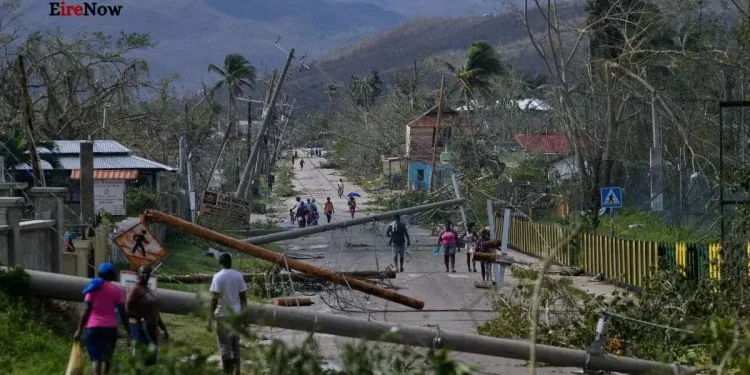KINGSTON / PORT-AU-PRINCE — Hurricane Melissa, described as one of the Caribbean’s most intense and slowest-moving storms on record, has unleashed widespread devastation across the region, leaving a preliminary death toll of at least 25 people in Haiti. The storm, which struck Jamaica as a Category 5 and later battered Cuba, has isolated communities and triggered a major humanitarian crisis.
Record-Breaking Intensity in Jamaica
Melissa made landfall in southwestern Jamaica on Tuesday with sustained winds of 298 km/h, surpassing the minimum for a Category 5 and becoming the strongest hurricane ever to directly hit the island.
The agricultural hub of St Elizabeth suffered immense damage, with aerial footage showing wrecked buildings, blown-off roofs, and downed power cables. Local authorities confirmed four bodies were washed up in floodwaters. As of yesterday morning, approximately 77% of Jamaica was without electricity.
Prime Minister Andrew Holness visited the hardest-hit areas, including Black River Hospital, where workers described the experience as “the most terrifying experience in all my life.” AccuWeather estimates the damage and economic loss in Jamaica could reach $22 billion, with rebuilding potentially taking a decade or more. Over 25,000 people have sought refuge in emergency shelters, which the government has ordered to remain open through the week.
Haiti: Flooding Kills Dozens Amid Crisis
Although Melissa did not make a direct hit on Haiti, days of torrential rain have proven deadly. Authorities reported at least 25 deaths, primarily due to severe flooding in the coastal town of Petit-Goave, where a river burst its banks.
Haiti’s disaster management agency reported that at least ten children were killed and 12 people remain missing. Nationally, over 1,000 homes have been flooded, and nearly 12,000 people are now in emergency shelters. The ongoing gang conflict and resulting displacement of over 1.3 million people have severely complicated aid efforts. Displaced residents, already lacking food, expressed fears of total catastrophe.
Cuba Suffers Extensive Damage and Isolation
The storm continued its path, hitting Cuba overnight as a still-major Category 3 hurricane with winds nearing 200 km/h. It made landfall near Guama, west of Santiago de Cuba, the island’s second-largest city.
President Miguel Diaz-Canel confirmed the island had suffered extensive damage. Preliminary reports indicated that at least 241 communities, affecting up to 140,000 residents, remained isolated and without communications yesterday across Santiago province. Authorities had preemptively evacuated around 735,000 people. Officials also issued warnings about the severe impact on crops ahead of the winter growing season, further compounding the existing shortages of food, fuel, and electricity.
Moving North-East
As of midnight Irish time, Hurricane Melissa had weakened to a Category 1 storm, bringing wind, rain, and storm surges through the Bahamas archipelago. The Bahamas government conducted one of its largest-ever evacuation operations, flying out nearly 1,500 people.
Some 1,440 km north-east, residents of Bermuda are now preparing for hurricane conditions forecast to begin today. Scientists note that hurricanes are generally intensifying faster with greater frequency, raising concerns about the future resilience of Caribbean infrastructure.







